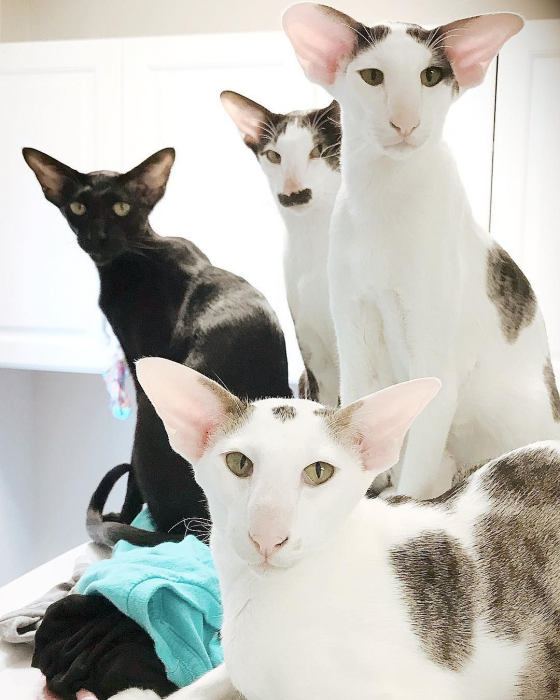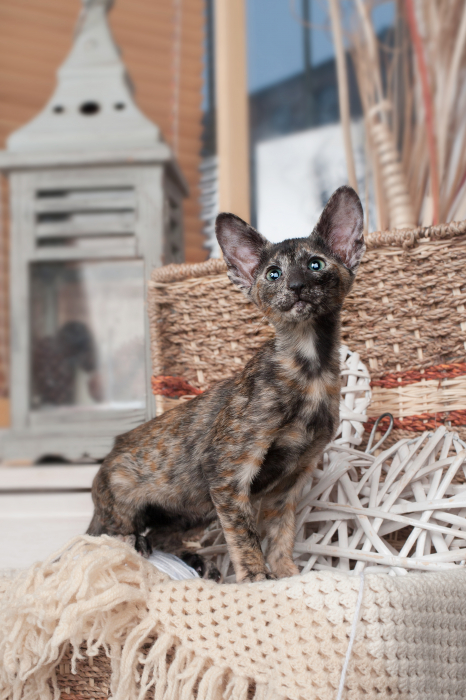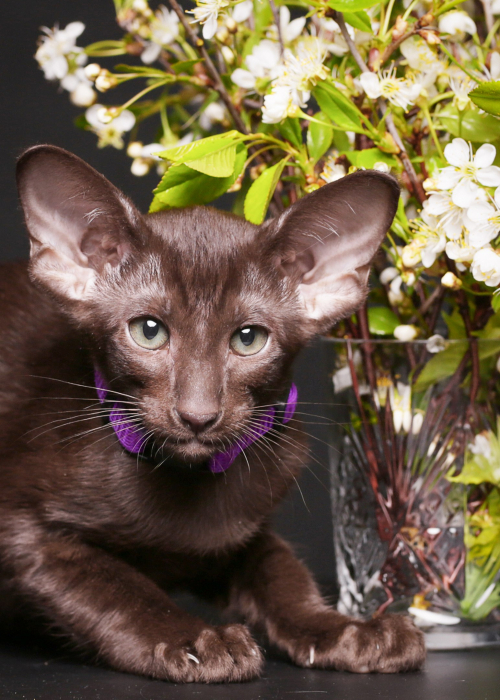Alien creature, not otherwise. It was such a thought that flashed through me at the sight of an oriental cat. I was just getting used to the specific type of sphinxes, as here - a new shock for my horizons.
The point, of course, is not at all that orientals have an ugly or repulsive appearance. They just look very unusual against the background of their four-legged "brothers."
Material Content:
History of breed origin
The historical homeland of the oriental cat is the country now called Thailand. It would seem, why is this breed in this case not called "Thai"? It's simple: almost until the middle of the 20th century, the state in Southeast Asia was called Siam. It became Thailand only after the Second World War. Consequently, the ancestors of the orientals ... correctly, Siamese tailed pussies with a vague character.

At the end of the 19th century, the "Siamese" gradually moved to England, and from there to other European countries. The standard and description of the breed were inexorable - a purebred individual should have blue eyes, as well as exclusively “Siamese” colors (dark color of paws, tail, muzzle, ears).
The litter with a monochromatic coloring, which appeared as a result of crossing the "Siamese" with other mustachioed, the stubborn British refused to recognize a separate breed. Perhaps that is why no one objected when, in 1956, one of these "defective" individuals was taken to the open spaces of America.After 2 years, the standard was adopted here for the resulting animals, which became known as oriental ones. English breeders have finally shown interest in graceful creatures and continued breeding, achieving new unusual colors.
Oriental cat description
Representatives of the oriental cat breed are distinguished by the following features:
- Ears: large, erect, triangular in shape, extended downward.
- The eyes are medium sized, almond-shaped.
Important. Blue eyes are found only in individuals of white colors. Animals with other shades of wool should be green-eyed.
- The tail is long, thin, tapering to the tip.
- The neck is long, graceful.
- The head is elongated, narrow, wedge-shaped. According to the requirements of the standard, the head, ears and chin of animals must form an equilateral triangle.
- The nose is flat, long.
- The body is medium in size with a strong skeleton, tucked up belly.
- The hind legs are wider than the front, larger in size.
As for the coat of "Thais", it can be long, short or absent altogether. Oriental longhair cat bred later shorthair, at the end of the last century.
It is interesting. The pride of the Northern capital of Russia is the hairless domestic cat bred here. These creatures are also called the St. Petersburg Sphinxes or Peterbalds. They appeared as a result of a "love affair" between the Don Sphinx and Oriental.
Varieties of color
The breed has more than 300 colors. It is no exaggeration to say that animals can shimmer with any color of the rainbow.

The following coloring options are distinguished:
- Purple or blue. The first has a pinkish undertones, soft and warm, and the second is a cool shade of gray.
- The black standard is called ebony. These magnificent creatures are real panthers in miniature. Animals are black until the very last hair (even the paw pads are black).
- Spotted or leopard individuals evoke the idea of resembling wild predators.
- Especially spectacular are the colors of fauns (beige), cinnamon (brown), tortie. The latter is obtained by mixing red and black stripes on the skins of pets. Interestingly, such a coloring is typical only for females.
- Marble - a special breed color. Marble kittens are born only if both parents have a similar color. In appearance, the rolled babies resemble chipmunks.
Did you know? Oriental chocolate colors with green eyes are practically not found in European countries. But in the United States such animals are classified as an independent breed called Havana Brown. In Europe, this “branch” was lost at one time due to mixing orientals with Siamese cats.
The most common colors are Siamese, brown, red, white, red.
Character, habits and features
Looking at the photo, it is difficult to imagine that an animal with an open, devoted look can have a bad temper, show aggressive qualities. Indeed, the character of the cat from Thailand is much milder than that of the proud Siamese.

Representatives of the breed differ from other cats in their love of food, conversation and people. Owners often note that pets are literally ready to follow them on the heels, causing the owner to dialogue in all possible ways: meowing, purring, etc. These creatures do not tolerate loneliness, but they love travel. Tactile contact is extremely important for them.
Graceful cats lend themselves well to training, like to play with various rustling objects, toys. In this case, the passion for fun remains with them until the venerable feline age. Get along well with children and other pets. Owners are often surprised when they get their pets out of closets, curtains, in a word, from everywhere where they can climb. Sometimes, it seems that these long-legged creatures can walk on the ceiling.
Life span
Life expectancy is 15 years.With proper care, the animal can live up to 20 years. Moreover, not only the physical, but also the psychological health of the pet (its relationship with the owner) plays a special role. The owner directly affects his emotional state. A lack of attention can lead to real depression. Therefore, people who always disappear at work should not have long-legged cats.
Care and maintenance
Graceful relatives of Siamese people equally well take root both in apartments and in a private house.
Important. The room should have a comfortable temperature. The absence of undercoat along with a thin coat does not allow these creatures to withstand the cold. The recommendation is relevant for both long-haired and short-haired cats - the fur in tetrapods performs a purely aesthetic function.
The house should also be protected from fragile objects, household chemicals, wires. As it grows older, the animal understands what is good and what is bad. But, despite all their high intelligence, mustachioed pets love to chew on green leaves. Therefore, windows and indoor plants pose a certain danger, even for adults.
"Thais" quickly become accustomed to the toilet.
Advice from the breeder
Orientals, like many cats, like to scatter filler crumbs. Therefore, I do not buy too light, for example, wood pellets, which fly apart, despite the mat laid under the tray. I usually look for a mineral filler (pebbles or clay). Its grains are heavier than wood. The main thing is to feel the packaging with your hand. Pellets should not be too sharp or scratchy. You can even use the tray without filler, with a surface mesh.
Source: https://prohvost.club/koshki/porody-koshek/orientalnaya-koshka-foto.html
Care is not complicated. Fur seals need to be wiped with a rubber glove or a massage brush (once a week is enough). After combing the pet's body, you can wipe it with pieces of moist suede or terry cloth. So the coat will have a beautiful and healthy appearance.
Particular attention should be paid to the teeth of tetrapods, as they are prone to gum disease. The pet should be accompanied regularly to the veterinarian to clean the tartar.
You should also periodically conduct activities to combat parasites. Ears also need care, they need to be systematically cleaned with cotton swabs.
The claws of graceful pets grow very quickly, so you need to cut them more often than the rest of the cat family - about 1 time per month.
Advice from the breeder
You can teach your cats to "bathing day". I taught my Hoshu, now once a week we have a spa. I used to pour warm water into a basin, lay a towel and put a cat there. She really does not like water, although she suffers. The whole bathing procedure with us is limited to washing the paws and holding a wet palm on her back. But while she was in a basin, I cleaned her ears and cut her nails, if necessary. Now I put a basin on the floor, and she comes and sits nearby - a reflex.
Source: https://prohvost.club/koshki/porody-koshek/orientalnaya-koshka-foto.html
Cat Nutrition Features
Looking at it, you might think that the animal is on a diet, or at least does not eat after 18 hours - these creatures are so elegant. However, they are always ready to eat, not forgetting to ask for an addition. The owner should not indulge the pet and overfeed him, but stand the time and determine the age volume of the portion. Uncontrolled eating can cause obesity, as well as the development of serious heart problems.
If the owner prefers ready-made feeds, it is better to choose products of the highest class. The beauty of a pet's fur coat directly depends on the amount of fat it receives. Therefore, in each serving of food should be added a few drops of vegetable oil.
If the owner opted for natural food, meat or offal can be mixed with vegetables or cereals in equal proportions.Pork, spicy, fatty dishes, sweets should be excluded from the menu.
Tip. Food should not be cold. The norm of daily calories for cats is 300, for cats - 250.
Common diseases
Breeders appreciate the breed not only for its distinctive appearance, but also for good health. However, problems with well-being can make themselves felt. The most common of these are retinal atrophy and flat chest syndrome.

The last ailment develops only in babies in the first months of life. The disease is considered genetic and can lead to chest deformity. This, in turn, prevents the full opening of the lungs, so the kitten will not be able to take a full breath. The result is oxygen starvation. With a weak form of the disease, the prognosis is favorable. But the kitten must endure 2 crises - in 10 days and in 3 weeks of life. The severity of the pathology is monitored by x-ray.
Retinal atrophy is also considered a hereditary disease. Partial or total blindness may result. The disease makes itself felt at any age. Typical signs of the disease do not exist, and therefore the owner himself is practically unable to understand that the cat is sick. This can be tracked by visiting a veterinary clinic.
Oriental cats are animals with an unusual appearance. It is this aspect that makes them popular among potential hosts. Hearing the voice of the host is the best reward for these sensitive and faithful creatures.
Three months ago, a chocolate Oriental kitten appeared in my house. I chose a pet for myself for a long time, but I did not know in favor of which breed to make a choice. I read a lot about different cats, looked at photos, until I saw orientals. And immediately fell in love with one photo, and when I read about all the features of this breed, I didn’t even search anymore - I want this particular pet and that’s it! And now this day has come - I bought a kitten and brought it home. At first it was exciting, because the kitten is still small, and I have not yet adapted to the care of it. But gradually everything went into its rut. Now the kitten has grown, eating quality food. The kitty is very affectionate, beautiful and very talkative - she exceeded all my expectations! By the nature of my work, I often go home and work remotely. And my darling follows me on the heels, sings, chatters, communicates. I am very glad that we found each other! Nika
Source: http://rasvutie.ru/poroda-koshek-i-kotov-orientalnaya-2.html#i-8












